Ferrous Metallurgy - UK Centre for Materials Education
advertisement
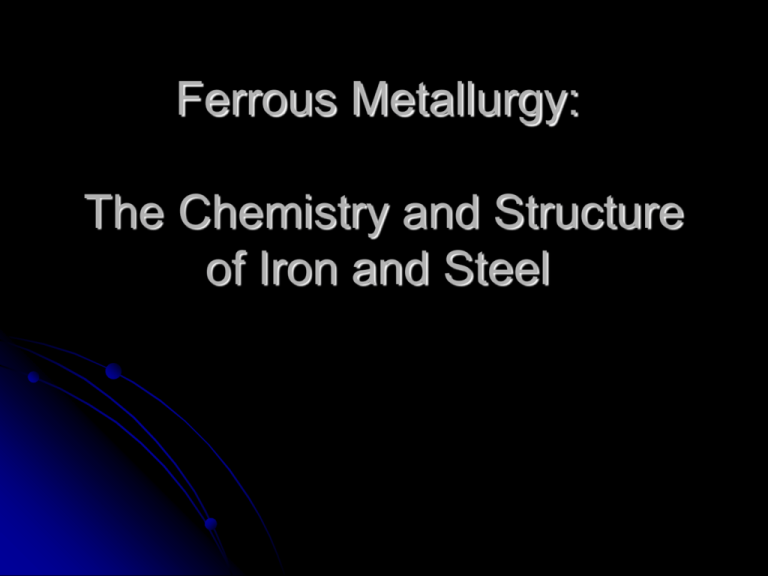
Ferrous Metallurgy: The Chemistry and Structure of Iron and Steel Pure Iron Iron from which the residual carbon left over from smelting has been removed. In the pure state it is a very soft grey metal Of no commercial use Wrought Iron Has approx 0.05% carbon Used since about 2000 BC Is stronger than most other pure metals. Made into weapons, armour, cooking pots and vessels Main limitation to wider uses due to processing (no way of making large items and no welding) Abraham Darby’s Ironbridge Cast Iron Between 2% & 4% carbon content Standard grey cast iron very brittle due to carbon rosettes in the structure acting as stress-raisers Possible to use heat treatment to improve the structure, this gives materials such as ductile iron and malleable iron (black heart) Ductile iron used in drain grids Grey cast iron showing the graphite flakes in a pearlite matrix Steel 0.001% to 1.5% carbon Wide range of properties due to: Variation in carbon content Cold working Heat treatment Addition of alloying elements Metals Ferrous metals Steels Non-ferrous metals Cast Irons Grey Iron Plain carbon steels Low carbon steels White Iron Medium carbon steels Malleable & Ductile Irons High carbon steels Low alloy steels High alloy steels Stainless & Tool steels Microstructure of Steel Five main constituents: Ferrite Austenite Cementite Pearlite Martensite Ferrite The structure of pure iron. Has a body-centred cubic (BCC) crystal structure. It is soft and ductile and imparts these properties to the steel. Very little carbon (less than 0.01% carbon will dissolve in ferrite at room temperature). Often known as iron. A photomicrograph of 0.1% carbon steel (mild steel). The light areas are ferrite. Austenite This is the structure of iron at high temperatures (over 912 deg C). Has a face-centre cubic (FCC) crystal structure. This material is important in that it is the structure from which other structures are formed when the material cools from elevated temperatures. Often known as iron. Not present at room temperatures. Cementite A compound of iron and carbon, iron carbide (Fe3C). It is hard and brittle and its presence in steels causes an increase in hardness and a reduction in ductility and toughness. Pearlite A laminated structure formed of alternate layers of ferrite and cementite. It combines the hardness and strength of cementite with the ductility of ferrite and is the key to the wide range of the properties of steels. The laminar structure also acts as a barrier to crack movement as in composites. This gives it toughness. Two-dimensional view of pearlite, consisting of alternating layers of cementite and ferrite. Three-dimensional analogy to the structure of pearlite, i.e. the cabbage represents a single crystal of pearlite, and the water in the bucket the single crystal of ferrite. Martensite A very hard needle-like structure of iron and carbon. Only formed by very rapid cooling from the austenitic structure (i.e. above upper critical temperature). Needs to be modified by tempering before acceptable properties reached. The needle-like structure of martensite, the white areas are retained austenite. Carbon In steels none of the carbon is present as free carbon. It is all dissolved in the iron as part of the previously described structures. 0.1% Carbon Steel Note the small amount of pearlite in the structure Applications A typical application of low carbon steel in a car body. Effect of Carbon Content Increasing the carbon content decreases the amount of ferrite and increases the proportion of pearlite in the structure. 0.2% Carbon Steel Note the increased amount of pearlite compared with the 0.1% ‘dead mild’ steel Eutectic Structure This leads to an increase in strength and hardness and a reduction in ductility. This continues until there is 0.8% carbon at which point the structure is 100% pearlite. This is known as a eutectic structure. Over 0.8% Carbon As carbon content increases beyond 0.8%, no more pearlite can be formed. The excess carbon forms cementite which is deposited in between the pearlite grains. This increases the hardness, but slightly reduces the strength. The ductility of all plain carbon steels over 0.8% carbon is very low. Properties of Carbon Steels Carbon content wt % Properties Applications 0.01 - 0.1 Soft, ductile, no useful hardening by heat treatment except by normalizing, but can be workhardened. Weldable. Pressings where high formability required 0.1 - 0.25 Strong, ductile, no useful hardening by heat treatment except by normalizing, but can be work-hardened. Weldable. Ductile-brittle transition temperature is just below room temperature General engineering uses for a mild steel 0.25 - 0.6 Very strong, heat treatable to produce a wide range of properties in quenched and tempered conditions. Difficult to weld. Can become brittle below room temperature. Bars and forgings for a wide range of engineering components. Connecting rods, springs, hammers, axle shafts requiring strength and toughness. Properties of Carbon Steels Carbon content wt % Properties Applications 0.6 - 0.9 Strong, whether heat treated or not. Ductility lower when less carbon is present Used where maximum strength rather than toughness is important. Tools, wear resisting components ( piano wire and silver steels are in this group). 0.9 - 2.0 Wear resistant and can be made very hard at expense of toughness and ductility. Cannot be welded. Tend to be brittle if the structure is not carefully controlled Cutting tools like wood chisels, files, saw blades.
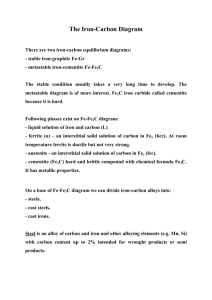
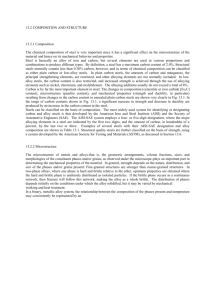

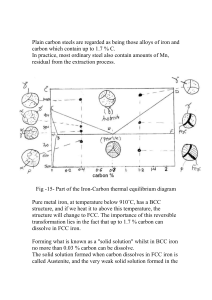
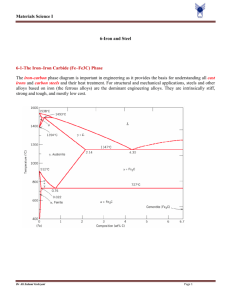
![Hlinsko [CR] > Praha přes Pardubice](http://s3.studylib.net/store/data/008946157_1-1c034385b612dae591a6c90cf1135c97-300x300.png)